About Me
Michael Zucchi
B.E. (Comp. Sys. Eng.)
also known as Zed
to his mates & enemies!
< notzed at gmail >
< fosstodon.org/@notzed >

Well ...
Just when you thought it couldn't get any worse, channel 9 - who hardly showed any of the world cup to start with - have what sounds like a horse-race caller doing the commentary on the AU/NZ semi-final. He does know the players at least, but doesn't seem to know the rules or that we too can see the same pictures as he is. So much for a bit of atmosphere, i had to turn the sound right down to be able to focus on the game and not this dickhead.
You don't realise how much the commentators make the game until you get a complete fuck-wit like this.
The one bright spot of the channel 9 coverage of the whole world cup - that they didn't provide their own wanker commentators - eclipsed in a moment.
Australia aren't looking like winners here after the first half, but there isn't much surprise there. Given a bit of bad luck and some very poor execution they're lucky they're still in it. NZ have made too many mistakes too.
Goodbye google news
Well, it's been a weekend for disappointment. Damn Wales were unlucky ... I'm actually not sure who I want to win out of New Zealand and Australia today - the kiwis just demand so much respect it's hard to barrack against them; i'll have a few drinks and go for whom-ever is playing the best I think. If they're both on their game it could be a real cracker of a match. But I digress ...
So, again google has decided to muck about with something which pretty much didn't need fixing. Last time they messed with news.google.com.au I wasn't particularly happy but continued to use it fairly regularly as the changes were just cosmetic usability issues but I think these latest changes are going to be too much on-top of a few other reasons i'll detail later.
TBH I can't believe i'm devoting so much time to such a post - it really doesn't mean that much to me on it's own - but in the over-all scheme of things these small (and not so small) issues do mount up. It turned into a bit of a mega-rant at the end and the language deteriorates as it goes ...
First, the existing google news as I see on this laptop ... starting with the top of the page:
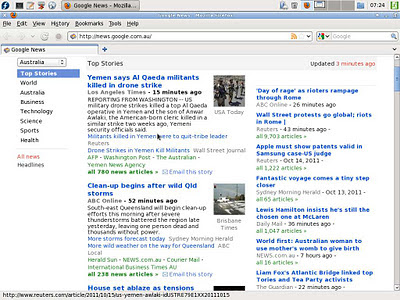
And then the middle of the page:

First thing: Yes I (very much) like to use Bitstream Vera Sans as my font for everything: coding, and reading documents. And even then, only 1 specific size works the best (not being able to do this is the single specific reason I wont even bother to try Chrome). So all you designers painstakingly choosing your typefaces and font sizes: you're wasting your time, if one can't read the information it is worthless. Most sites actually work fine with this, although a few have some minor formatting issues (mostly text overrunning the bottom of iframes).
And secondly I do have a crappy 1024x768 IBM laptop screen. Although few laptops have resolutions to match anymore, plenty of phones, netbooks and iLandfill slabs don't even get this far.
Ok, now on to the layout. There is still a big wasted load of space on the left that they added in the last major layout update, but basically most of the page is used for information content. Each story has a few alternative links from common (and sometimes not so common) news sources, an email link, and at most a single picture. Mouse-over's (at least today) are restricted to highlighting the link which is about the most i'd like any browser to do with them.
Now, to my suprise, I was greeted with the following page when I opened google news on my other laptop this morning:

Hmm, something doesn't look right. First, everything is in one column. A huge chunk of wasted space on both the left and the right now. And what's more, the real killer feature of google news - at a glance being able to see the 'feel' of the media reporting of the news story is conspicuously absent. There is only a single link to a single news source.
Actually I couldn't work out how to find anything more than that: I normally browse with Javascript disabled on that machine - because I don't like my lap burning, nor fæcebook to know where my mouse is whilst i'm reading a news article on an unrelated site - and all you end up with is a single link.
Enabling javascript and reloading, and I discovered a huge pile of annoying mouse-over shit (AMOS).

So, now you actually have to click an ugly button to bring this stuff up. Hoorah, now we have popup-pox infesting web pages too, just loverly[sic].
And on-top of that it's now somewhat more difficult to decipher - it is trying to add extra information to the other links beyond their titles. Do I really care that it is an opinion link? Or why the special notoriety of articles "From the United States [of America]"? Is their opinion somehow more important?
And apart from that, there's rubbish like a fæcebook, twatter, and plus-one button in addition to the email link, and 3 video links in addition to the picture. Clutter.
So ... I did a search and apparently the cog button is the settings icon these days. Who'd knew ... (actually I thought it was some logo, not a cog for that matter: it looks more to me like a high-contrast themed variation of the xfce main menu button) Of course, none of the buttons function if you have Javascript turned off ...
So to the rather bare settings. 1 or 2 columns, and auto-refresh. Færy-nuff, lets try ...
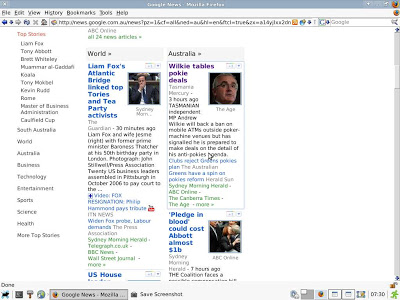
Oh hang on. That looks broken. Why would anyone possibly want to read the site that way? Not to mention more AMOS to 'enhance the experience', and the same big blank section on the right.
At least the killer-feature reporting-at-a-glance is back, but there's just no way anyone would labour through such a horrible interface for that.
Oddly enough ... if you disable javascript ...
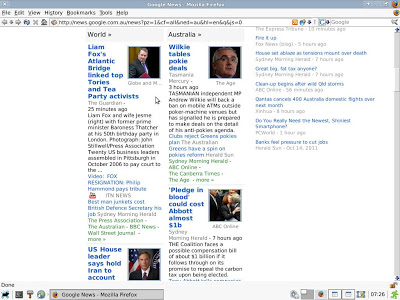
You get the right-hand side-bar back, and thankfully the AMOS disappears as well.
Well almost ...

For some reason the top of the page has this non-functional news selection slider thing stuck to it.
Thoughts
I can only think that google has a particular idea in mind here: if you're not using a 24" widescreen monitor, then you must be using a phone or some iLandfill toy. Although that doesn't completely make sense since the new site would be even more useless on phones so they must have 2 separate stylesheets/designs for each one anyway. So why fuck it up so royally?
More and more of the web requires javascript - whilst usually using it for pointless crap like implementing buttons in a non-recognisable os-agnostic way (those damn designers again, thinking they can redefine 30 years of progress in human-computer interaction on every page). I find this whole idea of javascript everywhere very questionable security wise - a web page can load 3rd party application which can then send information (e.g. where your mouse is) to any other 4th party without your knowledge. And hence more and more web pages are being turned into 'crapplications'. They're slower, uglier (and certainly not 'theme aware'), and more clumsy than local applications, but they're much heavier cpu and data wise compared to remote ones. It also closes off the avenues for using alternate browsers: having to have a very high performnace rendering engine and javascript vm is a massive barrier to entry (e.g. even firefox 3.6 is ruled out of many sites now).
Welcome to the 3rd age of thick-client computing. All the local computing power required to run local applications, combined with the speed, grace, availability and security of remote ones. Oh boy! Hold me back!
No news is good news?
On a personal note i've been trying to avoid reading the news too much anyway and google news itself. Its always the same old shit. It's mostly depressing, or at best it's just click-bait to rile you up.And google news's aggregation algorithms are pretty much like watching TV based on the ratings: not the sort of experience I'm really after. For example, apparently `funniest home videos' the most popular show in Australia? Do I really want the bogans who watch channel 9 deciding what news makes the front page (depressingly the truth is of course that yes, they already do). With such an ignorant population, no wonder 'no more boats' is a (an almost) winning election slogan around these parts, or that the global warming denialists get so much airtime. A timely reminder - and exactly what I thought the first time I saw the advert with the sound not muted (which is how I watch advertising if i'm watching 'live' tv, although my tv mute button wore out ...).
Still, I do like to check at least once every couple of days - least i become one of the ignorant masses if nothing else. Or to fill a spot to give my brain a rest or whilst waiting for a routine to run ... Unfortunately now I use Java there's no more waiting around for compilation - the 50KLOC bit of code I work on compiles and launches the application from scratch in about 1/2 a second (ant doesn't include resources properly in the jar without a clean rebuild - and building jars is the single terribly weak fucking reason to justify it's utterly shit and astronomically painful fucked up existence - so I have to do it every time when working on opencl code. Fucking adjective!).
I guess I can use fairfax for the little Australian news i'm after (democratic politics died for me when Howard went to war, and without that what is the point of listening to those arseholes - and without the politics there's fuck-all left), The Guardian for Europe and summaries or links in a few blogs I visit will do me from now. I gave up on The ABC months ago - which should really now just be called `The Opposition Says Sydney-Siders Gazette'. Even SBS TV news has been shit for ages, since they cut their budget it's little more than a patchwork of cheap stories from other services (many barely trying to hide themselves from the happy-story pro-war/pro-usa propaganda they are, like some of the BBC stuff from iraq/afghanistan).
Barely any of the services do any local news at all. Most of it is broadcast/published straight out of Sydney or Melbourne. Not that much of import happens around here, but sometimes you do need to know about local stuff.
One thing google news showed me (until now) is just how much of the news is just the exact same story repeated ad nauseam, so at least I know I wont be 'missing out' on anything by not using it.
Goodbye Mythtv
I knew there was a reason I hadn't updated my system in a while, it wanted install rubbish I don't want.
Dependencies Resolved
========================================================
Package Arch
========================================================
Removing:
PackageKit i686
Removing for dependencies:
PackageKit-glib i686
PackageKit-gstreamer-plugin i686
PackageKit-yum i686
k3b i686
k3b-common noarch
k3b-libs i686
kdebase-runtime i686
kdebase-runtime-flags noarch
kdebase-runtime-libs i686
kdelibs i686
kdemultimedia-libs i686
kdepimlibs i686
mythtv-common i686
mythtv-frontend i686
mythtv-libs i686
phonon i686
phonon-backend-gstreamer i686
qt-webkit i686
Transaction Summary
========================================================
Remove 19 Package(s)
Installed size: 161 M
Is this ok [y/N]:
All I can say is "What the Deuce?"
I'm pretty sick of fighting with this type of bullshit. Why the fuck is anything depending on that PackageKit crap?
So yes, it is ok to remove that snot - it's only a console that saves me walking into the next room to set what i'm going to record anyway. And it's only tv. wodim is easier to use than k3b for burning isos for that matter.How poetic ... (just arrived in email):
Date: Fri, 14 Oct 2011 00:13:22 -0400
From: "Wordsmith" <wsmith@wordsmith.org>
Subject: A.Word.A.Day--vituperation
This week's theme: Negative words
vituperation (vy-too-puh-RAY-shuhn, -tyoo-, vi-) noun
Bitter and abusive language; condemnation.
[From Latin vituperare (to blame), from vitium (fault) + parare (to make or
prepare). Earliest documented use: 1481.]
Later ...
So this episode got me searching for a blacklist option, and I found the exclude option for yum.
Yay!
exclude=PackageKit
exclude=pulseaudio
It seems it had something to do with the phonone-backend-gstreamer and there are alternatives which don't need such rubbish.
Never did like gstreamer ...
Chances are the mythtv guys have changed the database format again, so i might hold off on trying to install it anyway: i've had enough excitement for one day. The secret is N-tier architecture guys ...
Special-Case Code and Multi-Pass Algorithms
Ok, so without going into too much detail I have a function which needs to resample 3 float2 planes of data to another resolution, and then perform very simple arithmetic on it (a few mult, add). The scale factors are powers of two up and down. One complication is that the numbers have to be pre-sampled first at pixel corners before being interpolated.
I implemented it initially using bilinear interpolation for simplicity, and yesterday looked at implementing bicubic filtering.
It wasn't really that bad - the given routine was about 1.5x the original speed which is ok, and overall this was only a 3% impact.
But I thought I would try a few ideas to speed it up ...
A) I separated the routine into separate implementations, one for each scale. I still used the same sampling routine, but just passed it a fixed-value for the scale. In previous micro-benchmarks on the bilinear code I noticed this lead to a pretty decent improvement.
But in this case it didn't. It slowed down some scales by a factor of 1-2, and moreover, made other routines in the same source file execute slower(!). I can only assume the growth in code-size was a significant factor here. I also noticed the register usage hit 63 again - which probably means all i've done is hit a bug in the compiler again (I should really upgrade the driver: we're moving to AMD hardware RSN anyway).
B) Using two passes. A separate scale pass followed by a calculation pass. Intuitively this should be somewhat slower: the calculation after the scaling is simple and can be done in registers.
But of course it turned out faster. Not a huge amount, about 20% for the routine in question.
I did have to do some work to make it happen though: using local memory and 2d workgroup sizes, and separate code for the scaling down functions (e.g. it just sums 2x2 block to go down by 2). In this case using separate functions for each size worked quite well (more evidence of compiler bugs). I was also able to batch the 3 planes separately to get added parallelism - the problem size is quite small so this should hep.
... and after writing (C) below I re-arranged the upscaler to use hard-coded sizes as well, and re-did the bicubic interpolator to accept integer and offset values separately: the compiler can remove some of the calculations here since i'm always using the same pixel offsets.
... and i also experimented with changing the output type to float8 rather than float2 and writing 4 pixels at once for the 4x upscale. This was 2x faster again for this routine (and uses fewer registers?), although I can't trust this number as the results are now broken (and i really have had about enough of it and don't want to debug it).
C) Doing more at once. e.g. doing 1/2, 1, and 2x at the same time. Actually because the 2x scale uses hard-coded interpolation numbers the bicubic interpolation can be simplified greatly (that just gave me an idea to improve B) above).
I didn't get this incorporated because it required a bit of re-arrangement of the host code, but this could shave off a bit more. I usually need a few scales of the same data in each pass so this would be useful.
Conclusions
Although all these could also be applied to the bilinear code, I now (with the changes in B above) have bicubic interpolation for this routine running much the same speed as the original bilinear did.
But it shows that you sometimes don't want to do too much in a given routine - compiler bugs, register spillage, or just more registers end up being used, which adversely affect parallelism and performance. Although a trip to memory is quite costly, these other factors can greatly outweigh it.
After all this, and a few more changes in this particular routine i'm working on, I only managed about a 9% improvement. TBH i'm not sure it's really worth it ... and I probably only went so far as I had a bit of time between getting this to a working state and heading back to reading papers.
Awesome-ease Chicken
Been a while since i shared a recipe, and i've been making some variation of this fairly regularly of late ... This is a sort of kitchen-friendly variation on Portuguese Chicken done in an oven. And it's super-shit-easy to make. I used to make it on a BBQ but this is probably nicer to eat and easier to cook properly.
PS I admit i've had a couple of very lovely glasses of Church Block '07 and came up with the utterly-naff name which i've never used before. It's just a super-tasty roast chicken.
1. Cut chicken
Start by cutting a chicken up the breast-bone.

2. Prepare pan
Place a handful of (freshly picked of course) thyme in the middle of a suitably sized dish/oven-proof frying pan.
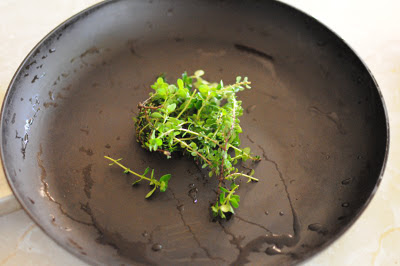
3. Mount the fowl
Push down on the back of the chicken to flatten it out - you should hear bones/joints breaking - if you're picky you can also break out the rib-bones at this point to make it easier to eat - and then place it over the thyme. I also poked it over with a fork to help the seasoning in and the fat out.
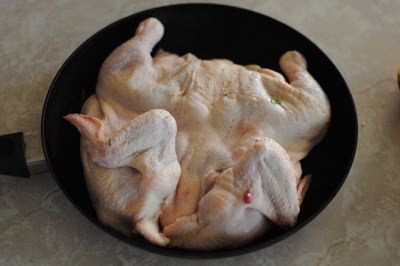
4. Seasoning, Lemon & Salt
Cover with the juice of one (small) lemon, and if you have it, about a 2 teaspoons of Asian 'chicken seasoning' - this is about 1/2 salt, with some flour, MSG, onion and stock powder mixed in. A good teaspoon of vegetta powdered stock, or simply salt and some pepper would suffice.
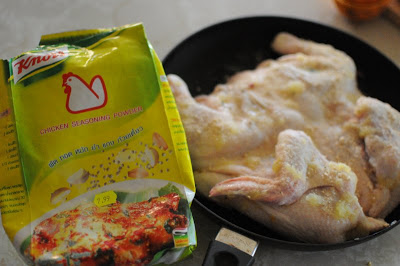
5. Seasoning, Herbs
Cover with broken fresh herbs (e.g. sage) and sliced ripe chillies. I also sometimes add a few thin slices of ripe tomato at this point, but my tomato plants are still growing this early in the season ...

6. Cook It
Being flat, it cooks a bit faster even at the normal 180C. I usually baste it a couple of times as well to bring out some colour, and when it looks cooked it usually is. This small fowl was an hour in a pre-heated oven - about 45-50 minutes/kilo rather than 60. I also upped the temperature for the last 15 minutes, but one has to be careful not to burn the herbs too much.

7. Eat It
Because the chicken is laid down flat it traps the steam inside and cooks from both the inside and outside at the same time (i'm sure the black pan helps). This cooks it faster and keeps it very moist. And with the skin upwards it crisps up nicely and builds up a strong flavour.
It scales in the obvious way to larger fowl - I've cooked up to size 20 chickens this way.
Wavelet Denoise & Sharpen
So I had some luck with a bit of fiddling with the scaling function for wavelet sharpening. And managed to get both sharpening and smoothing working at the same time. I'm fairly happy with the results.Update: see also a further post on using the DCT in a similar way.Update: I've now implemented a version of this in ImageZ, see the follow-on post
Ok, first the raw Lenna input image I used - converted to greyscale by Java2D. Just to make comparison easier and to add another pretty face to the page.

Now, with the sharpening ramped right up. As you can see it's pretty much the same as using unsharp-mask with a well-selected radius and a medium weight. And like unsharp mask it tends to emphasise any noise.

Unsharp mask/Wiener Deconvolution can still work better if the image is simply de-focussed as they have a PSF function to estimate the amount of defocusing.
Now, with the same settings, and also de-noised very heavily. Despite the obvious and unnatural looking heavy processing the edge sharpness and most of the detail is still retained rather well. Most added artefacts are relatively smooth and natural looking too. If you've ever tried using a median filter or a selective Gaussian blur, you'd know they pretty much suck at retaining any texture detail or clean edges.

And finally, a more natural level of sharpening and de-noising.

Pretty happy with it given how simple the maths is. I've over-emphasised some of the results by using high values, but a smooth variation in results between the original and any of the extreme values is possible.
Two steps are applied to each complex coefficient in turn in a way that can be done whilst the coefficients are in registers. So if you have other processing going on it's essentially free.
- Threshold De-noise
- C = C * { abs(C) > T ? ( abs(C) - T ) / abs(C) : 0 }
Where:
C the complex transform coefficient;abs(x) returns the magnitude of the complex number x;T input threshold from about 0.01 to 0.001.(see the previous post for a dead link to the source of this)
This zeros out small coefficients - which are apparently likely to be noise - and scales the rest to their original range.
- Scale Bands
- C = C * { ( exp( (bandcount - nband) * scale) - 1 ) * weight + 1 }
Where:
bandcount is depth of wavelet transform;nband is number of the band (0 is the highest frequency);scale input sharpness 'gradient' from 0-1; andweight input sharpness weight from 0-1.scale is a general 'sharpening factor' setting, and weight specifies how heavily it is applied.
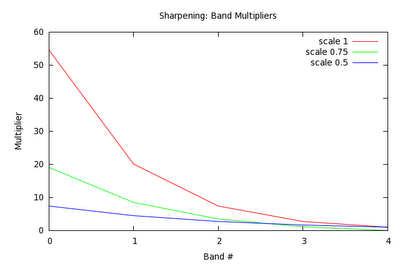
Wavelet Denoise
As a test routine for some low-level code I threw together a little test harness of a complex wavelet de-noise algorithm.It was based on some papers and demo code from this link (which appears to be dead now ... and has been for some time at that). It's just using a very simple threshold-and-scale of the wavelet coefficients, so apart from the relatively expensive Dual-Tree Complex Wavelet Transform it is simple and cheap to implement. The 1.7ms reported is the time to forward transform, apply the thresholding, the inverse, and download the (float) image to Java and convert it to a greyscale byte image. (I know, the screenshot should have been a png, so it's not entirely clear here ...)

This has nothing to do with what i'm working on but I thought it looked quite interesting. It preserves edge detail much better than techniques like a median filter or a Gaussian blur, and introduces fewer artefacts compared to the adaptive blurs i've seen. According to that now-broken-link, using the complex waveform produces subjectively better results compared to the DWT.
Perhaps i could use it as a processing step: if you already have the DTCWT coefficients it's a cheap additional process. Somewhat like doing a convolution in the frequency domain, it's basically free if you're already there.
I also played a bit with working out a sharpening algorithm on the weekend - I couldn't really find any simple papers: they all relied on adaptive processes, and the results reported didn't seems worth all the effort. In the end all I did was linearly scaled the coefficients by some made up numbers. Scale up for the highest frequency components and scale each subsequent wavelet band by 1/2 of the one above.

Unsharp Mask vs Wavelet Sharpen by scaling coefficients with approximately (but not a very good approximation) similar adjustment. Unsharp Mask is on the left.
The result is pretty much the same as unsharp-mask, but it only takes 1 tuning parameter instead of 2, and subjectively it appears to me to a smidgen less noisy. But I need to experiment a bit more, one would expect to be able to reduce the noise compared to unsharp mask and I think my low frequency scaling factors are out and it's affecting the tonal quality too much.
Sharpening ImageZ
I thought it about time to fix a few little bits and pieces with ImageZ that I actually use ... so I tackled some of that. I fixed some of the wiener deconvolution code - so that odd-sized images work for instance. I also tried thoroughly thread-ising it, although I only got a modest performance boost: jtransforms is already using multiple threads for the FFT which is the expensive bit.
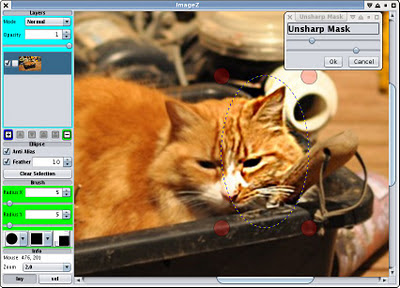
Unsharp mask in a feathered mask. I dialed it up to make it obvious.
Unsharp mask is something I always find really handy, so I finally coded that up too. Rather than start with the mess of the Gaussian filter code I already I have i coded another one from scratch. A bit simpler so I will merge and share the code at some point, or at least put it in a common place. It also mirrors the edges rather than clamping, which seems to produce a more natural response on the edges.
There are still a couple of things I use the gimp for that i'd rather not have to, but I guess that can wait for another day.
I really need to get out of the house this weekend, but i've pretty much pulled up all the weeds, it's been raining enough to water the garden, and the neighbours were using a chainsaw this morning. So I just found myself stuck at the computer again ... and I might watch the rugby on soon too.
Copyright (C) 2019 Michael Zucchi, All Rights Reserved.
Powered by gcc & me!





















